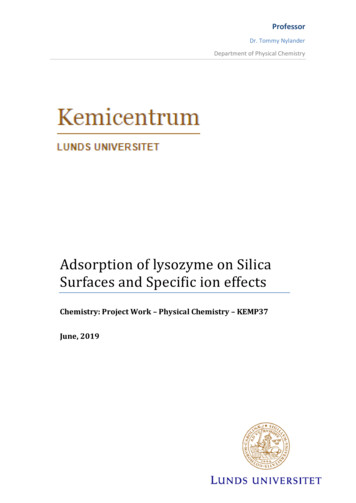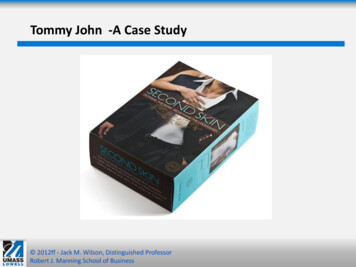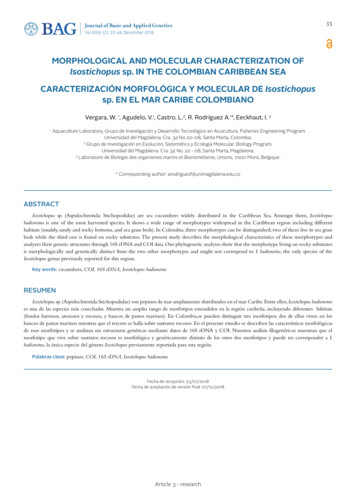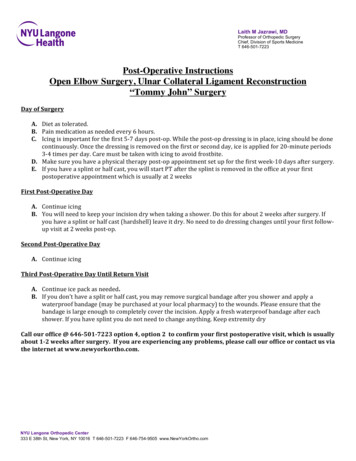
Transcription
ProfessorDr. Tommy NylanderDepartment of Physical ChemistryAdsorption of lysozyme on SilicaSurfaces and Specific ion effectsChemistry: Project Work – Physical Chemistry – KEMP37June, 2019
ABSTRACTBiomedical application of nanoparticles is largely associated to their fate inbiological media which, in fact, is related to their surface properties. Surfacefunctionalitzation plays a key role in determining biodegradation, cytotoxicity andbiodistribution through interactions which may be meditated by themacromolecules occurring in biological media. This project is focused on the effectof different buffers on lysozyme adsorption on flat silica surfaces andhydrophobized silica surfaces as well as mesoporous silica nanoparticlesfunctionalized with amino groups (MSN-NH2). In order to know the adsorptionamount of lysozyme we used ellipsometry, where each buffer has been studiedindependently at two different buffer concentrations at the same pH. The effect ofdifferent buffers can be related to specific ion effect described interaction ofbuffers and salts induces relevant effects on the charged interfaces (Hofmeistereffect), and thus lysozyme loading.Lysozyme adsorption on silica and hydrophobized silica as well mesoporous silicaat pH 7.15 was found to be buffer specific. The BES buffer seems to present aunique characteristic behavior which does not allow desorption. TRIS buffer showsthe highest lysozyme adsorption amounts, while citrate and phosphate bufferusually show quite similar results.The sequential addition of MSN-NH2 causes more extensive desorption of lysozymefrom the flat surface as observed with ellipsometry. Large effects of the buffer arealso observed. The competitive adsorption to the particles, i. e. lysozyme proteincorona formation, is likely to promote detachment from the silica surface.Keywords: mesoporous silica nanoparticles, ellispometry, surfaces, protein corona.1
‘’Be gentle to people when you go up; you will find them all whenyou go down’’ – Eduard Punset.First of all, I would like to express my deep gratitude to Professor TommyNylander, my project supervisor, for his guidance and opinions of this researchwork which perhaps it will result in a paper publication.Secondly, I would also like to thank for their advice and assistance to all personnelfrom the Physical Chemistry department. My grateful thanks are also extended theother PhD-students who helped me out and trained at some point.I am also deeply appreciated for receiving the MSNs samples to Professor AndreaSalis and Professor Maura Monduzzi from Università degli studi di Cagliari,Sardinia.I would also like to give recognition to my home university, Universitat deBarcelona (UB), for simplifying all the Erasmus paper work system.I wish to thank my parents for their support and encouragement throughout mystudy.Last but not least, I am deeply satisfied that I have finished this project with fruitfulresults although these were interrupted by my severe leg injury during thisErasmus.It has been a pleasure to study at the Physical Chemistry Department in LundUniversity.2
CONTENTS1. Introduction: Background and aim 42. Theory . .52.1 Ellipsometry2.1.1 The ellipsometry technique . 52.1.2 The ellipsometer . 52.2 Dynamic light scattering2.2.1 The DLS technique . 72.2.2 The DLS instrument . . 72.3 MSNs: a short explanation . 82.4 Functionalization . 82.5 Effect of buffer and salts . 82.6 Formation of a layer protein (corona) on modified Msn surfaces 102.7 Hofmeister effect . 103. Materials and Methods . 113.1 Materials . 113.2 Methods . .124. Results 154.1 Refractive index . 154.2 Light scattering . 164.3 Ellipsometry . 175. Discussion 386. Conclusion 487. References 498. Appendices . 513
1. INTRODUCTIONCancer is treated with chemotherapeutic drugs which are able to restrain tumor’sgrowth, but they are also toxic for healthy cells, thus resulting in adverse sideeffects. The use of improved pharmaceutical formulations, which release the drugat the target cancerous tissue only, would reduce undesired side effects of thechemotherapeutics. In this context, researchers are focusing on nanomaterials assmart carriers for targeted drug delivery and stimuli-responsive systems, usefulfor the treatment of cancer. [2]Ordered mesoporous silicates, synthesized for the first time in the early 1990s, arenanostructured materials with a big potential in nanomedicine applications.Among them mesoporous silica nanoparticles (MSNs) are promising drug carriercandidates for innovative pharmaceutical formulations. This thanks, as a result oftheir characteristic textural and structural features. Indeed, their high surface area(up to 1400 m2/g), the narrow distribution of pore size (1–2 Å), and the high porevolume (1–3 cm3/g), allow to load high amounts of drugs which can then bereleased at a sustained rate. [2]Moreover, the external surface of MSNs can easily be functionalized with targetbiomolecules, i.e. proteins (lysozyme in this study)/antibodies, peptides orsaccharides, that can be recognized by receptors that are overexpressed in tumorcells. [2]Alternatively, these macromolecules can modify their conformation, as a responseto a change of environmental conditions (i.e. pH), thus acting as astimuliresponsive system. In general, the external functionalization affects MSNsbiocompatibility, biodistribution, pharmacokinetics, particle stability, circulationtime, tumor accumulation, cellular uptake, and therapeutic efficacy. [2]When dispersed in a biological medium, nanoparticles (NPs) seek to lower theirinterficial energy by adsorbing biomolecules such as proteins, peptides, orglycolipids. This surface layer of biomolecules, known as the “protein corona” (PC),is due to the physico-chemical interactions established between the NPs and thebiomolecules occurring in the biological fluid. The nature of the PC depends onseveral NPs properties, such as, their chemical composition, size, shape, surfacecharge, and hydrophilic/hydrophobic character. PC also depends on thecomposition of the biological medium, and on proteins concentration in bloodplasma, temperature, administration route as well as composition of the cellmembrane. [2]Here the interactions between lysozyme (LYZ) with amino-functionalizedmesoporous silica nanoparticles (MSN-NH2) as well as flat silica andhydrophobized silica are investigated. The aim of the work is to reveal how proteinabsorbed amount and layers thickness is effect of ionic composition of the buffers.4
For this purpose, the interaction between LYZ and different silica surfaces werestudied using the following buffers salts: tris(hydroxymethyl)aminomethane(TRIS), citrate, phosphate and N,N-Bis(2-hydroxyethyl)-2-aminoethanesulfonicacid sodium salt (BES). In all cases, the pH was kept constant at 7.15 and both10mM and 50mM of buffers were investigated.In addition, the bulk properties of MSN-NH2 and LYZ were investigated in thedifferent buffer systems using light scattering and zeta potential measurements.2.0 THEORY2.1. ELLIPSOMETRY2.1.1. ELLIPSOMETRY TECHNIQUE:Ellipsometry is based on the measurement of changes in ellipticity of polarizedlight upon reflection. Ellipticity could be described as the ratio and phasedifference of two plane polarized light waves, one oscillating in parallel with theplane of incidence and the other perpendicular to it. It is used to accuratelydetermine thickness and refractive indices of films. Spectroscopic ellipsometryalso gives information on the absorption of the sample at different wave lengths. [3]Ellipsometry has a wide spectrum of application for the study of processes takingplace at surfaces. Here I have used ellipsometry as a tool for the study ofadsorption of proteins (lysozyme) at interfaces. [3]Often, the main interest concerning adsorption is the amount adsorbed per unitarea.The adsorbed amount (ɣ) can be calculated as [3]:ɣ 𝑑𝑑𝑓𝑓 ·(𝑛𝑛𝑓𝑓 𝑛𝑛0 )𝑑𝑑𝑑𝑑 𝑑𝑑𝑑𝑑Where df are the thickness values measured, nf are the refractive index of thebuffers measured by the ellipsometer, while n0 are the refractive index of thesolution and dn/dc is the index increment of the substance in the film (around0.140).2.1.2 THE ELLIPSOMETER:The ellipsometer used was a Rudolph thin film type 43603-200E (RudolphResearch, Fairfield, N.J., USA) has been used. The light source is a xenon arc lamplight source filtered to select a wavelength of 401.5 nm. The light beam passesthrough a sandwich consisting of two optical components, a plane polarizer and aquarter wave plate. By rotating this unit circularly polarized light with varyingintensity can be obtained. [3]5
The light then passes through a polarizer and then elliptically polarized light isgenerated by means of a retardation plate, a compensator. The ellipticity of thelight is then varied by means of rotating the polarizer. For a null ellipsometer, asused in the present study, the elliptically polarized light beam is adjusted in such away that it after reflected surface emerges as a linearly polarized light. [3] Therotation, azimuth, of the linearly polarized light after reflection is detected by usinganother polarized, i.e. the analyzer.The polarizer and analyzer prisms are provided with scales which allow thereading of the azimuth within a hundredth of a degree. The compensator is a firstorder quarter-wave plate set for a wavelength of 401.5 nm. [3]The light intensity after the analyzer is measured by a photomultiplier. [3]The stepping motor that rotates the polarizer and analyzer, as well as thecompensator, are connected to an interface which, in turn, is connected to apersonal computer. [3]The positions of the polarizer and analyzer giving minimum light intensity areobtained by using the so-called ‘’method of swings’’. While keeping the position ofthe analyzer fixed, the position of the polarizer is swept from its approximateminimum position, thus increasing the light intensity from 0,4 to 1,0 V. Thedirection of movement is then reversed until the same intensity is reached at theother side of the minimum. By assuming symmetry, the exact position of theminimum is obtained as the mean of the two values. The polarizer is nowpositioned at the value obtained, and the procedure is repeated for the analyzer. [3]The computer simultaneously performs calculations of the index of refraction forthe bare surface or the thickness, and the refractive index of the adsorbed layer,from which the amounts adsorbed for an adsorbed layer. Data are also stored forfurther evaluation. [3]The sample is immersed in a medium contained in a trapezoid cuvette (7mLvolume) made of fused quartz (Hellma, Germany), allowing light to passperpendicularly to the cuvette walls prior to and after reflection. The medium inthe cuvette is agitated with a magnetic stirrer. The temperature is controlled at25ºC by circulating thermostated water through the metal block that serves as thecuvette holder. [3]6
Figure 1. Rudolph ellipsometer used. [Source 1]2.2 DYNAMIC LIGHT SCATTERING2.2.1 THE DLS AND ZETA POTENTIAL TECHNIQUEThe dynamic light scattering (DLS), is a scattering technique that can be used todetermine the size average of suspended nanoparticles, including proteins,through fluctuation distribution. In this study, it will be used to determine somephysical properties on several solutions.Zeta potential is a physical property which is exhibited by any particle insuspension. It can be used to optimize the formulations of suspensions andemulsions. Knowledge of the zeta potential can be useful to predict long termsuspensions’ stability. Nevertheless, it was not useful in this study.2.2.2 THE DLS INSTRUMENTLight scattering. DLS - Malvern Zetasizer S. Serial MAL1019687.For convenient DLS and SLS measurements and determination of eletrophoreticmobility (or zeta potential), a Zetasizer Nano ZS from Malvern Instruments Ltd,Worshestershire, UK is used.The instruments measures DLS and SLS at a set angle of 173 using the NIBStechnology. The zeta potential (or electrophoretic mobility) measurements usingM3-PALS technology are performed at 20 C. The laser used is a 4 mW He-Ne laser(632.8 nm) and the detection unit comprises an avalanche photodiode. Thetemperature range of the instrument is 2-90 C.Disposable plastic cuvettes were used for the Zetasizer.7
2.3. MESOPOROUS SILICA NANOPARTICLES (MSN)The aim of this project is to reveal the effect of different buffers on lysozymeprotein adsorption on different surfaces. Protein adsorption in different types ofelectrolytes was measured in ellipsometry on silica wafers.A MSNs sample functionalized with amino groups has been used (MSN-NH2).These have a porous hexagonal ordered structure (2 nm, monodemal) with adistribuition of 1-3 cm3/g, compraising a high surface area (from 1000 to 1400m2/g). The particles size are about 100-120 nm with a zeta potential of 30 mV,although it has not been yet measured for our samples. [2]This study changes systematically the electrolytes composition and buffersolutions in order to see the Hofmeister effect on the adsorbed amount, which wasstudied though UV measurements in previous researches.The MSNs functionalized with amino groups (aminopropyl groups) were receivedfrom Professor Andrea Salis and Maura Monduzzi, Università degli studi di Cagliari,Sardinia.2.4. FUNCTIONALITZATIONWhen dispersed in a biological medium, nanoparticles seek to lower their surfaceenergy by adsorbing –on their surface- biomolecules such as proteins, peptides, orglycolipids. That process is known as functionalitzation. This surface layer ofbiomolecules, known as the “protein corona” (PC), is due to the physico-chemicalinteractions established between the NPs and the biomolecules occurring in thebiological fluid. The nature of the PC depends on several NPs features, such ge,and[1]hydrophilic/hydrophobic character.2.5. EFFECT OF BUFFERS AND SALTSLysozyme adsorption on mesoporous silica at pH 7,15 is buffer specific. Thesynergistic action of buffers and salts induces relevant effects on the chargedinterfaces, and thus on lysozyme loading. These findings, suggest the occurrence ofHofmeister phenomena also for buffers. [2]𝑝𝑝𝑝𝑝 𝑝𝑝𝑝𝑝𝑝𝑝 𝑙𝑙𝑙𝑙𝑙𝑙[𝐴𝐴 ][𝐻𝐻𝐻𝐻]Hofmeister (ion specific) effects are phenomena related to the chemical nature ofelectrolytes. Although they are ubiquitous in all chemical, colloidal, and biologicalsystems,1–5 they cannot be quantified in terms of the conventional physicochemical theories (i.e. Debye–Huckel, DLVO, etc.). These are limit theories, basedon electrostatics, and valid at infinite dilution only. The gap between theories and8
Hofmeister related experiments is usually very large since the ion specific effectsare generally observed at high concentrations in the presence of strongelectrolytes 0.3–3 M.6 This is very far from the validity's domain of both limit laws,and their extensions (valid up to 10-3 to 10-2 M).3 Nevertheless, it has beendemonstrated that high concentrations of strong electrolytes are not strictlynecessary to observe ion dependent phenomena. Several experiments showed thation specificity occurs at physiological salt concentrations (0.1–0.15 M), and evenbelow. [2]According to HH equation, it is necessary to fix the pH of the experiment for weakelectrolytes in order to give Hofmeister effects. Typical buffer concentrations are inthe range 10–100 mM for the experiments I will carry out (specifically, 10 and50mM). The implicit assumption is that, due to their low concentration, the bufferions should not display any specific effect. This is not so. Indeed it has recentlybeen observed that, even at the same nominal pH, lysozyme electrophoreticmobility was buffer dependent.The following buffer salts formulas were used:Figure 2. Molecular formulas of the buffer salts used at pH 7.15: A is monosodiumtris(hydroxymethyl)aminomethane (TRIS). B is trisodium citrate. C is monosodiumdihydrogen phosphate. D is 2-Amino-2-(hydroxymethyl)propane-1,3-diol (BES).9
Buffer saltBESCitratePhosphateTRISpKa (25ºC)7.13.13; 4.76; 6.402.12; 7.21; 12.678.07Charge at pH 7.151 negative3 negative1 negativePositive2.6. FORMATION OF A LAYER PROTEIN (CORONA) ON MODIFIED MSN SURFACESThe surface charge of functionalized MSNs modulates the interactions with LYZthough Van der Waals forces. A protein corona is due to interactions establishedbetween the nanoparticles and the bimolecules occurring (MSN-NH2) in thebuffered fluid (BES, citrate, phosphate and TRIS).Figure 3. Representation of a protein corona. NPs are attached to the surfaceprovoking a two layers protein corona. [Source 2]After administration of nanoparticle (NP) into biological fluids, an NP–proteincomplex is formed, which represents the “true identity” of NP in our body. Hence,protein–NP interaction should be carefully investigated to predict and control thefate of NPs or drug-loaded NPs, including systemic circulation, biodistribution, andbioavailability. [5]2.7. HOFMEISTER EFFECTThe Hofmeister series is a classification of ions in order of their ability to saltout or salt in proteins. [6] The effects of these changes were first worked outby Franz Hofmeister, who studied the effects of cations and anions on the solubilityof proteins. [7]10
Hofmeister discovered a series of salts that have consistent effects onthe solubility of proteins and (it was discovered later) on the stability oftheir secondary and tertiary structure. Anions appear to have a larger effect thancations [8], and are usually ordered.The mechanism of the Hofmeister series is not entirely clear, but does not seem toresult from changes in general water structure, instead more specific interactionsbetween ions and proteins and ions and the water molecules directly contactingthe proteins may be more important. [9] Recent simulation studies have shown thatthe variation in solvation energy between the ions and the surrounding watermolecules underlies the mechanism of the Hofmeister series. [10-11]Early members of the series increase solvent surface tension and decrease ffect,they strengthen the hydrophobic interaction. By contrast, later salts in the seriesincrease the solubility of nonpolar molecules ("salting in") and decrease the orderin water; in effect, they weaken the hydrophobic effect. The salting out effect iscommonly exploited in protein purification through the use of ammonium sulfateprecipitation. [12]In our low concentration ranges where ionic strengths are low, the salting in effectis produced. This refers to the effect where increasing the ionic strength ofa solution increases the solubility of some solute (such as a lysozyme protein). [13]3. MATERIALS AND METHODS3.1 MATERIALS Lysozyme powder from chicken egg white (Sigma-Aldrich). Muramidase or N-acetylmuramide glycanhydrolase. 0,5 g were dissolved at 50mL ofMiliQ water. The solution (10mg/mL) has been stored at the lab fridge a 4ºCand renewed every six weeks.BES 99 % for biochemistry (ACROS ORGANICS). N,N-Bis(2-hydroxyethyl)2-aminoethanesulfonic acid, N,N-Bis(2-hydroxyethyl)taurine. CAS 1019118-1. The BES solutions were prepared dissolving the powder into MiliQWater, then the pH was adjusted to 7,15 with NaOH or HCl prepared also inMiliQ Water.TRIS(HYDROXYMETHYL) AMINOMETHANE (Sigma-Aldrich). The TRISsolutions were prepared dissolving the powder into MiliQ Water, then thepH was adjusted to 7,15 with NaOH or HCl prepared also in MiliQ Water.Sodium citrate tribasic dihydrate. ACS reagent 99,0% (Sigma-Aldrich).C6H5Na3O7·H2O. The citrate solutions were prepared dissolving the powderinto MiliQ Water, then the pH was adjusted to 7,15 with NaOH or HClprepared also in MiliQ Water.Di-Sodium hydrogen phosphate anhydrous (AnalaR NORMAPUR). Na2HPO4.The phosphate solutions were prepared dissolving the powder into MiliQ11
Water, then the pH was adjusted to 7,15 with NaOH or HCl prepared also inMiliQ Water. Mesoporous silica nanoparticles functionalized with amino grouos (MSNNH2). These have a porous ordered (hexagonal) structure with monomodalpore size (about 2 nm) distribution and high surface area (around 1000m2/g). Usually the particle size is about 100-120 nm and zeta potentialaround 30 mV. Silica wafers. The surface was cut in a 1,2x2cm surface. The hydrophilicsurfaces were cleaned and positively charged. The hydrophobic ones weresilanized with a O layer3.2 METHODSMainly, only these three techniques were used: Ellipsometry for surface characterization. Ellipsometer Rudolf model 43603200E.In order to study the adsorption of the lysozyme on a silica surface depending onthe buffer, some ellipsometric measurements have been carried out. A sample of0.5 mL of the previous lysozyme solution was added to a 5 mL cuvette containingeach one of the buffers.The substrates were cleaned first in a base mixture of 25% NH4OH, 30% H2O2 andH2O (1/1/5, by volume) at 80ºC for 5 min, and rinsed with water, followed by anacid mixture of 32% HCl, 30% H2O2, and water (1/1/5, by volume) at 80ºC for 5min. The substrates were thoroughly rinsed with water and then ethanol, to bestored in 99,7% ethanol and then plasma cleaned (except for silanized surfaces). [3]The hydrophobic silica surfaces were prepared by a gas-phase silanization. Thesurfaces were placed in a desiccator with 1 mL of dimethyloctylchlorosilane(DMOCS) with a vacuum pump and left overnight at room temperature. [3]The ellispometry equipment needed to be calibrated before each measurement.The calibration process included steps such as setting the compensatormicrometer at 19.519, cuvette alignment, surface alignment and finding theminima and zone.In pursuance of studying the interaction effects, lysozyme adsorption wasmeasured for in 10 and 50mM blank buffers on both kinds of surfaces, and with theMSN-NH2 interactions.At first, desorption was measured while rinsing the cuvette with buffer at a pace of10mL/min for 5 minutes. Afterwards, the measurements had to stop temporally12
when the nanoparticles were added for 30 min, as they were too opaque andblocked the light stray. Light scattering. DLS - Malvern Zetasizer S. Serial MAL1019687. Refractive Index. B S Abbe 60/ED refractometer:For the ellipsometry, the RI at a certain wave length was necessary as it was aparameter imputed into the softeware.This technique permits the refractive indices (RI) at multiple wave lenghts, with ahigh precision. This allows to extrapolate or interpolate the measured values anddetermine the RI of a sample at a particular wavelength, e.g. 632.8 nm (the one of ared He-Ne laser.) The accessible range is from 1.30 to 1.74. 2. A spectral bulb, thathas several well-known strong peaks of the emission, is used to illuminate thesample. An OSRAM mercury-vapor bulb mounted inside an extemal holder wasused.The refractometer is calibrated in a way that the position of a refracted spectralline can be recorded as a scale reading. The value of the scale reading isunambiguously converted into the refractive index with a free software or withcalibration tables.Figure 4. B S Abbe 60/ED refractometer parts.In the optical sight three referenced wave lenghts are represented in three rangesof colours are represented. The optical cross has to point the field’s border in orderto calibrate it. Distilled MiliQ water was used as a test sample:13
Figure 5. Wave lengths color fields though the optical scale telescope.Figure 6. Abbe Utility Program. Software calculator.14
4.0 RESULTS:CHEMICAL COMPOUNDS USED:All following materials and have been prepared with MiliQ water: 10 mg/mL Lysozyme solution (renewed every 6 weeks)10, 50 mM BES buffer solution at pH 7.1510, 50 mM Citrate buffer solution at pH 7.1510, 50 mM Phosphate buffer solution at pH 7.1510, 50 mM TRIS buffer solution at pH 7.15Solid amino-functionalized mesoporous silica nanoparticles4.1 REFRACTIVE INDEX CALCULATIONThe refractive index of the buffer solutions has been measured with therefractometer B S Abbe 60/ED at multiples wavelengths. An OSRAM mercuryvapor bulb mounted inside an external holder was used. The software used to treatthe data is called Abbe Unility.Buffer solution 435.8 nm546.1 nm579.0 nm50 mM BES1.370571.341361.3662950 mM Citrate1.342241.367211.3711150 mM1.341171.366101.37038Phosphate50 mM TRIS1.341391.366171.3701010 mM BES1.340561.365121.3694210 mM Citrate1.340471.365361.3696010 mM1.340451.365081.36947Phosphate10 mM TRIS1.340281.366121.36927The values that the ellipsometer takes into as the buffer refractive index are at435.8 nm, the closest measured to 401.5 nm on which the ellipsometer works.ɣ 𝑑𝑑𝑑𝑑 · (𝑁𝑁𝑁𝑁 In order to readjust the values and data given:SymbolɣdfnfnoDn/deConceptAmount adsorbed(mg/m2)ThicknessRI values from theellisometerBuffer RIRI increment of thelysozyme in the filmDataMeasuredMeasuredBufferMiliQ waterDepending on the buffer(circa. 0.18)15
4.2 LIGHT SCATTERING:In order to know the size of the nanoparticles, DLS measurements were taken.0,1mL of lysozyme were added with a syringe into 1mL of the correspondentbuffer in a plastic disposable cuvette:10 mM buffer Size average 4Deviation (nm)Result (nm)96.644.975.34.711000 (100)400 (40)400 (80)100 (5)10 mM buffer LYZZeta Potential (mV)BES7.91Citrate0Phosphate0.829TRIS2.52All values have to be around 0 mV.Deviation (mV)2.1700.2660.53As the deviation values were that high, the same samples were left overnight to seeif aggregation in suspended particles was a key factor which did not allow to takeproper measurements.Aggregation10 mM buffer .1Average Deviation (nm)Result (nm)706.2360.8996.619.2Inconclusive1300 (400)Inconclusive140 (20)50 mM buffer LYZSize Average (nm)Deviation 6.9TRIS253.440.4These last two table results are inconclusive due to the random aggregation andhigh deviation.16
4.3 ELLISPOMETRYAll surfaces are cut in a 2x1.2cm size. (Note: that hydrophilic surfaces are notspecified in the subtitles, only the hydrophobic ones)The first half of the following graphs are for the lysozyme adsorption in a buffer(without MSNs). Thickness (nm) will be represented on the left axis in blue. Theamount of lysozyme adsorbed (mg/m2) will be represented on the right axis ingreen.When MSNs are being used, adsorption will be represented in red instead ofgreen.Knowing that at T 298K and desorption rate was over a pace of 10mM/min. Thefollowing results have been gathered:ADSORPTION FROM 10M M BUFFERS200180160140120100806040200010002000Time (s)300054,543,532,521,510,504000Amount (mg/m2)Thickness (nm)10mM BES LYZdadsGraph 1. A 4.5 mL of 10mM BES solution and 0.5 mL of lysozyme were measured withRudolph ellipsometry.The adsorbed amount is then desorbed from around 4,25 to 3,25 mg/m2. Resultsare noisy as it was the first ellipsometric ever taken.17
me(s)3000Amount (mg/m2)Thickness (nm)10mM Citrate LYZ0,5dads04000Graph 2. A 4.5 mL of 10mM citrate solution and 0.5 mL of lysozyme were measuredwith Rudolph ellipsometry.The adsorbed amount is then desorbed from around 3.25 to 1.9 mg/m2.10090807060504030201000100020003000Time (s)400054,543,532,521,510,505000Amount (mg/m2)Thickness (nm)10mM Phosphate LYZdadsGraph 3. A 4.5 mL of 10mM phosphate solution and 0.5 mL of lysozyme weremeasured with Rudolph ellipsometry.The adsorbed amount is then desorbed from around 4.25 to 3.5 mg/m2.18
200180160140120100806040200252015105020004000Time (s)6000Amount (mg/m2)Thickness (nm)10mM TRIS LYZdads08000Graph 4. A 4.5 mL of 10mM TRIS solution and 0.5 mL of lysozyme were measuredwith Rudolph ellipsometry.Desorption has not been measured due to stirring problems.The same kind of measurements was measured again in order to have more properresults and compare the reproducibility:Thickness (nm)3002502001501005000200040006000Time (s)800054,543,532,521,510,5010000Amount (mg/m2)2nd: 10mM BES LYZdadsGraph 5. A 4.5 mL of 10mM BES solution and 0.5 mL of lysozyme were measured withRudolph ellipsometry for a second time.The adsorbed amount increases after rinsing the cuvette.19
200180160140120100806040200020004000Time (s)600054,543,532,521,510,508000Amount (mg/m2)Thickness (nm)2nd: 10mM Citrate LYZdadsGraph 6. A 4.5 mL of 10mM citrate solution and 0.5 mL of lysozyme were measuredwith Rudolph ellipsometry for a second time.Desorption was not 06000Time (s)8000Amount (mg/m2)Thickness (nm)2nd: 10mM Phosphate LYZdads010000Graph 7. A 4.5 mL of 10mM phosphate solution and 0.5 mL of lysozyme weremeasured with Rudolph ellipsometry for a second time.The adsorbed amount is then desorbed from around 5.0 to 3.4 mg/m2.20
2nd: 10mM TRIS bufferThickness (nm)72006515041003250002000400060008000Amount (mg/m2)8250dads1010000Graph 8. A 4.5 mL of 10mM TRIS solution and 0.5 mL of lysozyme were measuredwith Rudolph ellipsometry for a second time.The rinsed amount is barely desorbed.10mM Citrate LYZAmount Time (s)50007000Graph 9. The 4.5 mL of 10mM citrate solution and 0.5 mL of lysozyme ellipsometricmeasurements were compared in order to rule out the different result.First and third measurements are identical, thu
Professor Dr. Tommy Nylander Department of Physical Chemistry . Adsorption of lysozyme on Silica Surfaces and Specific ion effects Chemistry: Project Work - Physical Chemistry - KEMP37










